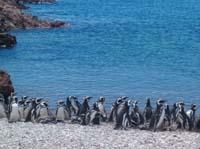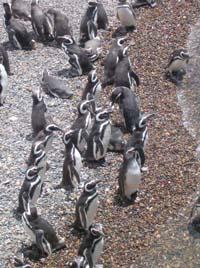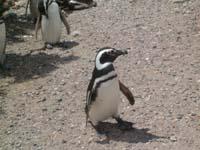Magellanic penguin under anchovy fishing

Punta Tombon hosts the largest penguin colony of Magellan.
(Photo: L. Cancio)
The penguin of Magellan, for the moment, is not in danger of extinction. However, according to a paper published in the journal Science, the anchovy fishery may endanger the species.
In fact, anchovies are a staple food for both penguins and other animals living in their environment: sea lions, dolphins, cormorants... But in 2003, near Punta Tomás, Argentina authorized the experimental fishing of the anchovy of the southeast Atlantic.
According to environmentalist Elizabeth Skewgar, however, the Argentine government granted the authorization without studying the influence of anchovy fishing on the penguin population. Science's work explains that for the moment the influence of fishing has not been detected, since there has been no overfishing (about 30,000 t in 2004 and so many in 2005). But he fears that in the future they will fish much more, as demand continues to grow. And Skewgar warns that if fishing grows, anchovy would be small for penguins.
Last example
To see what consequences overfishing does not need to go far: Basque fishermen and fishermen are very concerned about the evolution of anchovy and other species. However, in Argentina there is a clear example.

Anchovies are basic in feeding penguins.
(Photo: L. Cancio)
Twenty years ago, Argentine fishermen fished the hake of Merluccius hubbsi in the future. There was a lot of hake and most of the catches were exported. However, in the 1990s it was discovered that hake was declining and in 1999 the Argentine government declared that hake fishing was in an emergency situation. Due to the diminishing presence of hake, measures were attempted to reduce fishing.
However, they realized that it was extremely difficult to overturn the trend. These measures ended the trade of many people. Meanwhile, the hake population sank and the government totally banned areas that were once precious fisheries. The social crisis worsened and efforts to implement a quota system were unsuccessful.
Before late

The future of the Magellanic penguin is linked to anchovy.
(Photo: L. Cancio)
Skewgar believes that something similar to anchovy in the southeast Atlantic can occur. Such a large loss in the population of anchovy as that of hake would greatly affect, not only fishermen, but also penguins. Incidentally, the tourism industry would also suffer losses due to the influx of tourists attracted by penguins.
For Skewgar, now is the time to limit anchovy fishing. It is time to carry out the necessary studies to decide where to set the limit and to develop models to predict the evolution of anchovy. Before being late.
Published in 7K.
Buletina
Bidali zure helbide elektronikoa eta jaso asteroko buletina zure sarrera-ontzian











